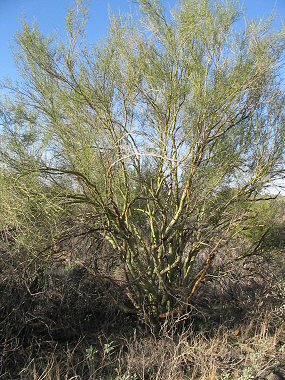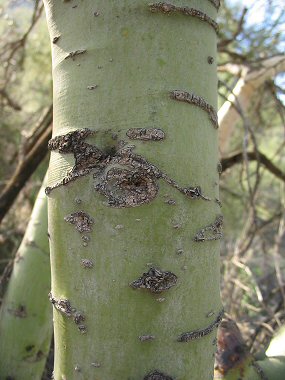The Littleleaf Paloverde (also called
Yellow or Foothill Paloverde) is a member of the Pea
Family.
 It
appears as a multi-trunked large shrub or small tree that grows to 25
feet in height. The branches are stiff and usually all grow in an
upwards direction, which allows it to be distinguished from its cousin
the Blue Palo Verde, whose lower branches tend to droop to the ground.
Each twig on the branches of the tree ends in a stiff thorn which grows
to 2 inches in length. As the name suggests, the elliptical leaflets of
the plant are quite small, growing to only 1/16th of an inch. Leaves are
dropped during the drier months to reduce evaporation (draught
deciduous). Without leaves, photosynthesis is carried on by the the
chlorophyll in the bark which gives the tree its green color. It
appears as a multi-trunked large shrub or small tree that grows to 25
feet in height. The branches are stiff and usually all grow in an
upwards direction, which allows it to be distinguished from its cousin
the Blue Palo Verde, whose lower branches tend to droop to the ground.
Each twig on the branches of the tree ends in a stiff thorn which grows
to 2 inches in length. As the name suggests, the elliptical leaflets of
the plant are quite small, growing to only 1/16th of an inch. Leaves are
dropped during the drier months to reduce evaporation (draught
deciduous). Without leaves, photosynthesis is carried on by the the
chlorophyll in the bark which gives the tree its green color.
|
The Palo Verde is the state tree
of Arizona. Palo Verde means 'green stick' in Spanish. |
The plant blooms between March - May and produces pale
yellow flowers with 5 petals to 0.5 inches in width. Flowers are
pollinated by numerous species of bees that gather the pollen for food
for their grubs. Flowers are followed by a cylindrical pod (sort of like
a pea pod) which grows to 3 inches in length. After seeds mature, they
fall to the ground where they are eaten and dispersed by a variety of
rodents including ground squirrels and pocket mice who gather and bury
the seeds to eat later. Seeds were also used by Native Americans who
would eat young seeds much like peas. The paloverde typically grows in
dry rocky areas along hillsides and in low lying deserts at elevations
between 500 - 4000 feet.
|

